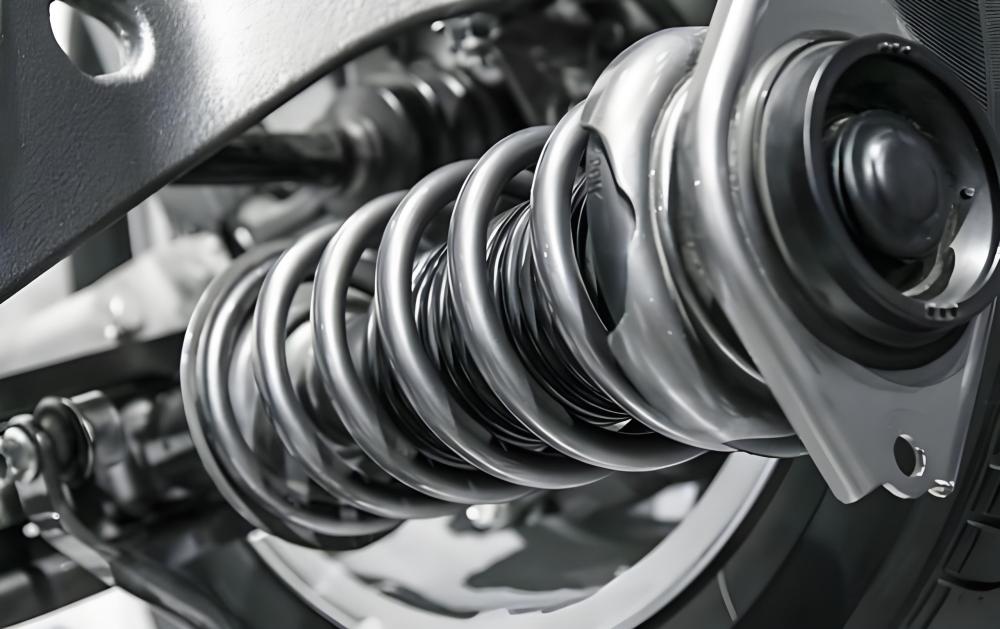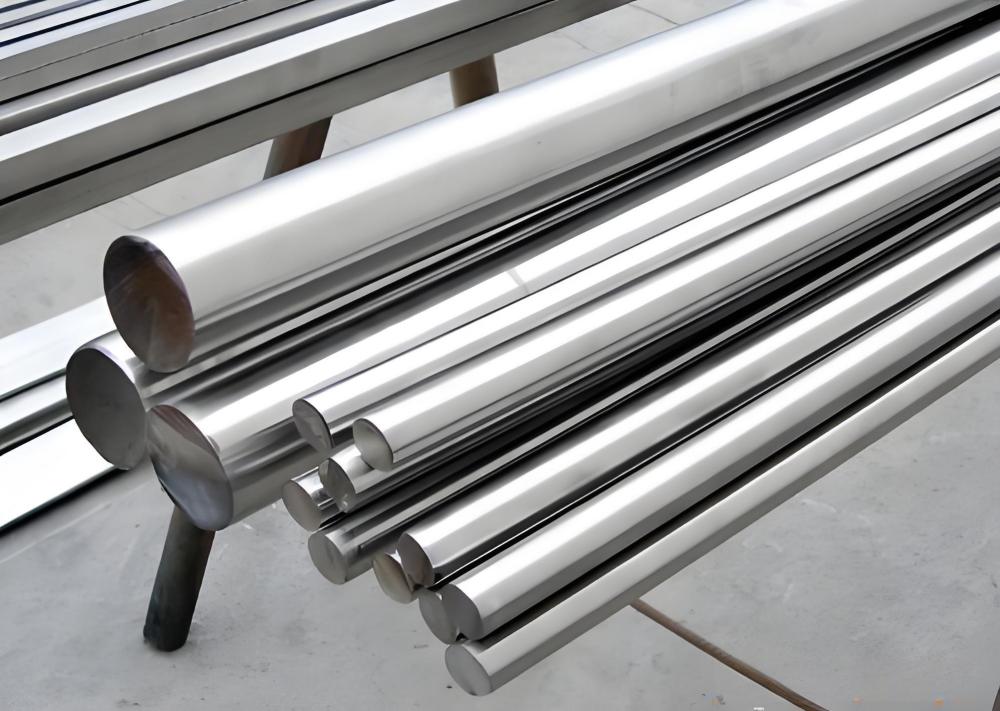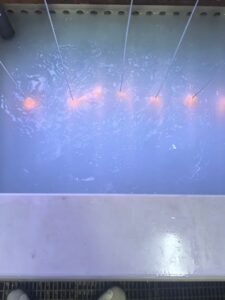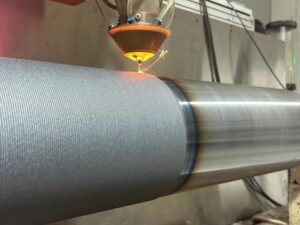What Is 5160 Steel?
5160 steel is a high-carbon, chromium-alloy spring steel renowned for its balance of strength, ductility, and fatigue resistance. Often referred to as AISI 5160 or SAE 5160, it belongs to the family of spring steels, which are designed to withstand deformation and return to their original shape. The designation “5160” comes from the AISI/SAE naming system, where the first digit “5” indicates a chromium-based alloy, and the last two digits “60” reflect approximately 0.6% carbon content. This composition gives 5160 steel its characteristic toughness and resilience, making it a go-to material for components that endure high stress and repetitive loading.
This steel is particularly valued in industries where durability and flexibility are critical. Its ability to absorb shock and resist fatigue makes it a favorite for applications like leaf springs in vehicles or heavy-duty tools. While it’s not the easiest material to machine or weld due to its high carbon and chromium content, proper techniques can unlock its full potential. For those in the machining industry, 5160 steel offers a rewarding challenge with impressive results when handled with care.
5160 Carbon Steel Chemical Composition
The unique properties of 5160 steel stem from its carefully balanced chemical composition. This alloy is primarily composed of iron, with specific elements added to enhance its performance. Below is a breakdown of the key components:
- Carbon (C): 0.56–0.64% – Contributes to hardness and strength, enabling the steel to hold an edge and resist wear.
- Chromium (Cr): 0.7–0.9% – Enhances hardness, tensile strength, and corrosion resistance, though not to the level of stainless steel.
- Manganese (Mn): 0.75–1.0% – Improves strength and toughness, aiding in grain structure refinement during heat treatment.
- Silicon (Si): 0.15–0.35% – Increases strength and heat resistance, contributing to the steel’s elasticity.
- Phosphorus (P): ≤ 0.035% – Controlled to prevent brittleness and maintain machinability.
- Sulfur (S): ≤ 0.04% – Improves machinability but kept low to avoid compromising toughness.
This composition creates a steel that’s tough yet flexible, with enough wear resistance to handle demanding applications. The chromium content, while not high enough to classify 5160 as stainless, provides a moderate level of corrosion resistance, making it suitable for environments where rust is a concern but not the primary issue. For machinists, understanding this composition is key to selecting the right tools and techniques for working with 5160 steel.
Properties of 5160 Steel
Physical Properties
The physical characteristics of 5160 steel are one of the main reasons for its popularity. These include:
- Density: Approximately 7.85 g/cm³
- Melting Point: Around 1425–1530°C (2597–2786°F)
- Thermal Conductivity: Roughly 51.9 W/m-K
- Electrical Conductivity: Moderate, but not typically used for electrical applications
Its density and high melting point make it stable under high stress and temperature conditions, a key requirement for automotive and heavy-duty industrial use.
Mechanical Properties
Mechanical properties define how 5160 steel behaves under various forces and loads. Key mechanical characteristics include:
- Tensile Strength: Up to 220 ksi when properly heat-treated
- Yield Strength: Around 140 ksi
- Elongation: Approximately 20%
- Modulus of Elasticity: 190-210 GPa
- Hardness: Can reach 57-60 HRC after heat treatment
These attributes make 5160 an ideal choice for parts subjected to bending, twisting, and impact.
How to Heat Treat 5160 Steel?
Heat treatment is critical to unlocking the full potential of 5160 steel, as it enhances its hardness, toughness, and durability. The process involves several steps, each requiring precision to achieve the desired properties. Here’s a step-by-step guide to heat treating 5160 steel:
Annealing
Annealing softens 5160 steel, making it easier to machine or shape. To anneal, heat the steel to 700–750°C (1292–1382°F) and hold it at this temperature for 1–2 hours. Then, allow it to cool slowly in a furnace or insulated environment. This process reduces internal stresses and improves machinability, which is essential for complex machining operations.
Normalizing
Normalizing refines the grain structure, enhancing toughness and reducing the risk of distortion during hardening. Heat the steel to 870–900°C (1600–1650°F) and hold it for about 10–15 minutes, then allow it to cool in still air. This step prepares steel for hardening by creating a uniform microstructure.
Hardening
To harden 5160 steel, heat it to 800–850°C (1472–1562°F) and hold it for 10–15 minutes to ensure even heating. Then, quench the steel in oil to rapidly cool it, locking it in a hard martensitic structure. Preheating the steel to 500–700°C (932–1292°F) before austenitizing can reduce thermal shock and prevent cracking. The resulting hardness is typically 57–60 HRC, ideal for blades and springs.
Tempering
Tempering reduces brittleness while maintaining hardness. After hardening, heat the steel to 200–300°C (392–572°F) for 1–2 hours, depending on the desired balance of hardness and toughness. For applications like springs, a slightly higher tempering temperature (around 400–450°C) may be used to increase flexibility. After tempering, allow the steel to cool slowly to room temperature.
Proper heat treatment is essential for tailoring 5160 steel’s properties to specific applications. For example, a knife blade may require higher hardness for edge retention, while a leaf spring needs more flexibility to absorb shock. Machinists and manufacturers must carefully control heating and cooling rates to avoid defects like cracking or warping.
What Is 5160 Steel Used For?
5160 steel’s unique combination of toughness, flexibility, and fatigue resistance makes it a versatile material across multiple industries. Here are some of its most common applications:

Automotive Industry
In the automotive sector, 5160 steel is a staple for manufacturing leaf springs and coil springs used in vehicle suspensions. Its ability to withstand repeated stress and return to its original shape ensures reliable performance in trucks, cars, and heavy-duty vehicles. The steel’s high tensile strength and fatigue resistance make it ideal for components that endure constant loading, such as suspension springs and torsion bars.
Knife and Sword Making
5160 steel is a favorite among knifemakers and blacksmiths for crafting survival knives, machetes, and swords. Its toughness and impact resistance allow blades to handle heavy-duty tasks like chopping or batoning without chipping or breaking. While it doesn’t offer the same edge retention as higher-carbon steels like 1095, 5160 steel is easier to sharpen and excels in applications requiring durability over fine edge retention. Its flexibility also makes it a top choice for swords, where blades must flex without snapping.
Heavy Machinery and Industrial Tools
Beyond automotive and cutlery applications, 5160 steel is used in heavy machinery for components like shackles, pins, and bushings. Its ability to handle high stress and resist fatigue makes it suitable for parts in construction equipment, agricultural machinery, and industrial systems. The steel is also used for hand tools like hammers, axes, and wrenches, where durability and impact resistance are paramount.
Agricultural Equipment
In agriculture, 5160 steel is employed in springs for plows, harrows, and cultivators. Its resilience ensures that these components can withstand the rigors of fieldwork, from rocky soils to heavy loads. The steel’s cost-effectiveness also makes it an attractive choice for manufacturers looking to balance performance and budget.
Custom and Specialty Applications
Blacksmiths and custom fabricators often choose 5160 steel for unique projects, such as arrowheads for traditional archery or decorative pieces like hooks and hinges. Its versatility in heat treatment allows craftsmen to tailor its properties to specific needs, making it a popular choice in bespoke manufacturing.
Challenges and Considerations in Working with 5160 Steel
While 5160 steel offers impressive properties, it does present some challenges in machining and fabrication. Its high carbon and chromium content make it harder to machine than low-carbon steels like 1018. Annealing is often necessary to soften the steel before cutting, milling, or drilling, as unannealed 5160 can quickly wear down tools. Carbide tools or high-speed steel (HSS) with coatings like AlTiN are recommended, along with slower cutting speeds (around 85–350 SFM, depending on the tool) to minimize heat buildup and tool wear.
Welding 5160 steel is also challenging due to its high carbon content, which can lead to cracking in the heat-affected zone. Preheating to 200–300°C (392–572°F) and using low-hydrogen electrodes with SMAW or GTAW methods can help mitigate these issues. Post-weld tempering is often necessary to restore toughness. For machinists, controlling heat during CNC machining is critical to prevent work hardening or dimensional inaccuracies.
Corrosion is another consideration, as 5160 steel is not highly corrosion-resistant. Regular maintenance, such as applying oil or protective coatings, is essential for parts exposed to moisture. Despite these challenges, the steel’s mechanical properties make it worth the effort for applications requiring toughness and flexibility.
Comparing 5160 Steel to Other Steels
To understand 5160 steel’s place in the machining world, it’s helpful to compare it to other popular steels:
- 5160 vs. 1095 Steel: 1095 has higher carbon content (0.95%), offering better edge retention but less toughness than 5160. It’s easier to sharpen but more prone to rust. 5160 is preferred for larger blades and springs, while 1095 suits smaller knives requiring sharp edges.
- 5160 vs. 52100 Steel: 52100 has higher carbon (0.98–1.1%) and chromium (1.3–1.6%), making it harder and more wear-resistant but less ductile. It’s ideal for bearings, while 5160 excels in spring applications.
- 5160 vs. 420HC Steel: 420HC is more corrosion-resistant due to higher chromium (12–14%) but less tough and wear-resistant than 5160. It’s better for kitchen or pocket knives, while 5160 is suited for heavy-duty tools.
These comparisons highlight 5160 steel’s niche as a tough, flexible material for high-stress applications, though it requires careful handling during machining and maintenance.
Tips for Machining 5160 Steel
For machinists working with 5160 steel, the following tips can improve efficiency and results:
- Anneal Before Machining: Softening the steel through annealing reduces tool wear and improves machinability.
- Use High-Quality Tools: Carbide or coated HSS tools are essential for cutting through 5160’s hardness.
- Control Cutting Speeds: Use slower surface speeds (85 SFM for HSS, 350 SFM for carbide) to minimize heat and extend tool life.
- Apply Coolant: Proper coolant application prevents work hardening and maintains dimensional accuracy.
- Plan for Heat Treatment: Factor in post-machining heat treatment to achieve the desired hardness and toughness.
By following these practices, machinists can overcome the challenges of working with 5160 steel and produce high-quality components.
Partner with Precionn for Your 5160 Steel Machining Needs
5160 steel’s combination of toughness, flexibility, and fatigue resistance makes it an excellent choice for applications where reliability under stress is critical. Its versatility allows it to shine in automotive, industrial, and custom fabrication settings. While it requires careful machining and maintenance, the results are durable, high-performance parts that stand the test of time.
For companies like Precionn, 5160 steel represents an opportunity to deliver precision-machined components that meet the demands of diverse industries. With a deep understanding of this material’s properties and machining requirements, Precionn leverages advanced CNC techniques and heat treatment processes to create parts that excel in performance and durability. Whether you’re designing suspension components, crafting custom tools, or exploring innovative applications, Precionn’s expertise in machining 5160 steel ensures good results tailored to your needs.




